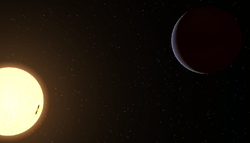AA Tauri
AA Tauri is a young variable star in the equatorial constellation of Taurus, located in the Taurus-Auriga star-forming region. It is too faint to view with the naked eye, having an apparent visual magnitude that varies from 12.2 down to 16.1.[2] The star is located approximately 447 light years away from the Sun based on parallax, and is drifting further away with a radial velocity of +17 km/s.[4]
 Artist's impresion of AA Tauri and possible substellar companion | |
| Observation data Epoch J2000.0 Equinox J2000.0 | |
|---|---|
| Constellation | Taurus |
| Right ascension | 04h 34m 55.42227s[1] |
| Declination | +24° 28′ 53.0383″[1] |
| Apparent magnitude (V) | 12.2 to 16.1[2] |
| Characteristics | |
| Spectral type | K7Ve[3] |
| Variable type | T Tauri-type?[3] |
| Astrometry | |
| Radial velocity (Rv) | 16.98±0.04[4] km/s |
| Proper motion (μ) | RA: +3.483[1] mas/yr Dec.: −20.987[1] mas/yr |
| Parallax (π) | 7.2888 ± 0.1295[1] mas |
| Distance | 447 ± 8 ly (137 ± 2 pc) |
| Details | |
| Mass | 0.76[5] M☉ |
| Radius | 1.81[5] R☉ |
| Luminosity | 0.8[5] L☉ |
| Temperature | 4,060[5] K |
| Rotational velocity (v sin i) | 12.8±1.1[4] km/s |
| Age | 2.4[5] Myr |
| Other designations | |
| Database references | |
| SIMBAD | data |
The stellar classification for this object is K7Ve,[3] matching a K-type main-sequence star that displays emission features. It is an eruptive variable of the T Tauri type[2] with an estimated age of 2.4 million years. The object has 76% of the mass of the Sun, 181% of the Sun's radius,[5] and is spinning with a projected rotational velocity of 13 km/s.[4] AA Tauri is radiating 80% of the luminosity of the Sun at an effective temperature of 4,060 K.[5]
Variability
AA Tauri shows brightness variations of one to two magnitudes over an 8.2-day period. The brightness has been described as "roughly constant, interrupted by quasi-cyclic fading episodes".[7] The periodic variations are ascribed to eclipses of the star by a warped dust disk around it.[8]
In 2011, AA Tauri faded by about two magnitudes and has remained at the fainter level since then. The star also became significantly more reddened. The eight-day variations continue, with a maximum brightness now around magnitude 14 and magnitude 16.5 at its faintest. It is theorised that the root cause of this dimness is a warp in the accretion disk, located at a distance of 7.7 AU or more from the centre, that was brought into the line of sight by its elliptical motion around the central star.[9]
A possible planetary system
In their paper of 2003, Grinin et al. invoke the possible presence of a substellar object to explain peculiar and periodic eclipses occurring to the young star every 8.3 days.[7] They infer a mass of 20 times that of Jupiter for the perturbing object and an orbital separation of 0.08 Astronomical Units. Later studies find no evidence for a planet, instead finding multiple rings with accretion streams between them.[8]
| Companion (in order from star) |
Mass | Semimajor axis (AU) |
Orbital period (days) |
Eccentricity | Inclination | Radius |
|---|---|---|---|---|---|---|
| b (unconfirmed) | ≤20 MJ | 0.08 | 8.5 | 0 | — | — |
References
- Brown, A. G. A.; et al. (Gaia collaboration) (August 2018). "Gaia Data Release 2: Summary of the contents and survey properties". Astronomy & Astrophysics. 616. A1. arXiv:1804.09365. Bibcode:2018A&A...616A...1G. doi:10.1051/0004-6361/201833051. Gaia DR2 record for this source at VizieR.
- Samus, N. N.; et al. (2017). "General Catalogue of Variable Stars". Astronomy Reports. 5.1. 61 (1): 80–88. Bibcode:2017ARep...61...80S. doi:10.1134/S1063772917010085.
- Herbig, G. H. (1977). "Radial velocities and spectral types of T Tauri stars". Astrophysical Journal. 214: 747–758. Bibcode:1977ApJ...214..747H. doi:10.1086/155304.
- Nguyen, Duy Cuong; et al. (February 2012). "Close Companions to Young Stars. I. A Large Spectroscopic Survey in Chamaeleon I and Taurus-Auriga". The Astrophysical Journal. 745 (2): 25. arXiv:1112.0002. Bibcode:2012ApJ...745..119N. doi:10.1088/0004-637X/745/2/119. 119.
- Güdel; et al. (2007). "The XMM-Newton Extended Survey of the Taurus Molecular Cloud (XEST)". Astronomy and Astrophysics. 468 (2): 353–377. arXiv:astro-ph/0609160. Bibcode:2007A&A...468..353G. doi:10.1051/0004-6361:20065724.
- "AA Tau". SIMBAD. Centre de données astronomiques de Strasbourg. Retrieved 2019-08-10.
- Bouvier; et al. (2003). "Eclipses by circumstellar material in the T Tauri star AA Tau. II. Evidence for non-stationary magnetospheric accretion". Astronomy and Astrophysics. 409: 169–192. arXiv:astro-ph/0306551. Bibcode:2003A&A...409..169B. doi:10.1051/0004-6361:20030938.
- Loomis, Ryan A.; Öberg, Karin I.; Andrews, Sean M.; MacGregor, Meredith A. (2017). "A Multi-ringed, Modestly Inclined Protoplanetary Disk around AA Tau". The Astrophysical Journal. 840 (1): 23. arXiv:1704.02006. Bibcode:2017ApJ...840...23L. doi:10.3847/1538-4357/aa6c63.
- Bouvier, J.; Grankin, K.; Ellerbroek, L. E.; Bouy, H.; Barrado, D. (2013). "AA Tauri's sudden and long-lasting deepening: Enhanced extinction by its circumstellar disk". Astronomy & Astrophysics. 557: A77. arXiv:1304.1487. Bibcode:2013A&A...557A..77B. doi:10.1051/0004-6361/201321389.